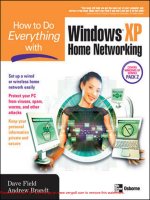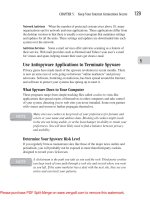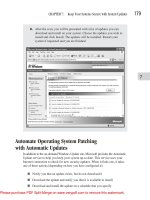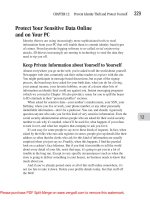Tài liệu How To Do Everything With Windows XP Home Networking- P4 ppt
Bạn đang xem bản rút gọn của tài liệu. Xem và tải ngay bản đầy đủ của tài liệu tại đây (1.46 MB, 50 trang )
Network Antivirus When the number of protected systems rises above 10, many
organizations opt for network antivirus applications. These applications differ from
the desktop versions in that there is usually a server program that maintains settings
and updates for all the units. These settings and updates are downloaded into each
system over the network.
Antivirus Services Some e-mail services offer antivirus scanning as a feature of
their service. Web mail providers such as Hotmail and Yahoo! scan user’s e-mail
for viruses and spam, helping ensure their users get clean e-mail.
Use Antispyware Applications to Terminate Spyware
Privacy gurus have made much of the spyware revolution in recent months. There
is now an arms race of sorts going on between “online marketers” and privacy
advocates. Software, bordering on malicious, has been spread around the Internet,
and software to protect your systems has sprung up to meet it.
What Spyware Does to Your Computer
These programs range from simple tracking files called cookies to virus-like
applications that spread copies of themselves to other computers and take control
of your system, directing you to web sites you never intended. Some even partner
with viruses and worms to further propagate themselves.
Many sites use cookies to keep track of your preferences for formats and
colors or your name and address data. Blocking all cookies might result
in the site not being usable, or at the least hamper its ability to retain your
preferences. You will most likely need to find a balance between privacy
and usability.
Determine Your Spyware Risk Level
If you regularly browse mainstream sites like those of the major news outlets and
periodicals, you will probably not be exposed to more than third-party cookies
designed to record your clickstream.
A clickstream is the path you take as you surf the web. Third-party cookies
can keep track of your path through a web site and record where you went
as you left. If the same marketer has a deal with the next site, they see you
arrive and can track your patterns.
CHAPTER 5: Keep Your Internet Connections Secure
129
5
Please purchase PDF Split-Merge on www.verypdf.com to remove this watermark.
130
How to Do Everything with Windows XP Home Networking
If you go to the more out-of-the-way places, however, you run the risk of more
insidious contacts. Some spyware authors use advanced hacking techniques to
implant spybots in your system that take control of your browsing (Browser
“Helper” Objects) and send you where they want or capture your keystrokes and
passwords.
A Browser Helper Object (BHO) is an application embedded into the Internet
Explorer environment that “helps” you use Internet Explorer. These can
actually be helpful (Spybot Search & Destroy installs a protective BHO to
block spyware), or they can be malicious. Many malicious BHOs will
watch your keystrokes and open additional windows to search sites with
your keywords already entered. The result is an annoyance to you and
a few pennies to the BHO author who gets paid per click by the site they
just sent you to.
Select an Antispyware Application
Antispyware comes in several flavors. Some applications include all the features
we will discuss; some specialize in only one or two.
Pop-Up Blockers Pop-up blockers block the pop-up and pop-under ads you see
when you enter web sites. The extra windows these sites open simply never appear
when the blocker is running. Some tools that do this are the free Google toolbar;
later versions of the Mozilla, Firefox, and Opera browsers; and Internet Explorer
(with Windows XP Service Pack 2).
Ill 5-13
Cookie Management Most antispyware applications will allow you to block or
manage cookies. This can range from blocking third-party cookies to blocking or
warning about all cookies offered to your browser.
Please purchase PDF Split-Merge on www.verypdf.com to remove this watermark.
CHAPTER 5: Keep Your Internet Connections Secure
131
5
Registry Protection Some spyware removal applications will inoculate your
Registry and alert you to any attempted changes to it. Spybot Search and Destroy
is especially good at this.
Ill 5-14
Configure Antispyware
When using antispyware, it is important to configure it to accommodate your
usage patterns and preferences. If you love getting offers for “free stuff,” you
probably won’t mind seeing the pop-ups. If, however, you want few distractions,
you might severely restrict the ability of spyware to see into your lifestyle.
There Are Alternatives
to Internet Explorer
In this book we concentrate on securing Internet Explorer, as it is the browser
built into Windows XP. There are some other very good web browsers available
on the Internet for free download. Mozilla and Mozilla Firefox, Opera, and the
text-based Lynx browser all offer alternatives to Internet Explorer. By not offering
direct support for ActiveX controls, they can be more secure from malicious
controls embedded in web sites. Some even include pop-up blockers, password
managers, and cookie management features.
Be warned, however, that Internet Explorer remains on your system and
must be kept patched. Even if it is not used for web browsing, any vulnerabilities
discovered may still affect your system.
If you choose to install an alternative browser, which we recommend, be
sure to choose the option to make it your default browser when asked by the
application.
Please purchase PDF Split-Merge on www.verypdf.com to remove this watermark.
Look for settings that block third-party cookies and pop-ups. Enable Registry
protection if available and configure the application to automatically update its
detection patterns if possible.
Maintain Antispyware with Application Updates
Antispyware software is only as good as the author’s ability to keep up with the
latest spyware tactics. Most applications offer the ability to download new detection
patterns and program updates. You should always update your detection patterns
before a scan. New spyware appears almost every day and would go undetected
without these updates.
Ill 5-15
Use Third-Party Internet Firewalls to Block Hackers
While Windows XP with Service Pack 2 offers a very comprehensive firewall,
there are also inexpensive third-party firewalls worth evaluating. They excel in
detecting attacks and may be simpler to configure.
132
How to Do Everything with Windows XP Home Networking
Please purchase PDF Split-Merge on www.verypdf.com to remove this watermark.
5
How Third-Party Firewalls Differ from Windows Firewall
Third-party firewalls work in ways similar to Windows Firewall but may differ in
key areas. Manageability is probably the most apparent. Personal firewalls like
ZoneAlarm offer full intrusion detection and the ability to interactively configure
application filters (the equivalent of Windows Firewalls “exceptions”) to suit your
needs. Another differentiater is performance. A hardware firewall such as those
built into Internet gateway devices offers faster filtering performance than those
that must wait for CPU cycles from your computer.
Hardware Firewalls
Whether you select a firewall built into an Internet gateway device or a stand-alone
firewall, it will most likely sit at the border between your network and the Internet.
This location offers a choke point for Internet traffic, allowing the device to monitor
all traffic going into and out of the network. Hardware firewalls are typically more
difficult to configure when you need something other than the default settings,
but they offer better performance and physical separation from your systems.
Manufacturers of firewalls for home networks also have configuration wizards that
will assist you with initial configuration.
Software Firewalls
Software firewalls install on your systems and protect each one individually. They
are typically simpler to install and configure, having their own setup wizards and
the ability to obtain information from your network applications and create settings
based on the application’s requirements. Even when you choose a hardware firewall,
it may be a good idea to install software firewalls on each system on the network.
This helps to implement a practice called “defense in depth,” which we will discuss
toward the end of this chapter.
Select a Third-Party Firewall
You may select your firewall because it is bundled into an Internet security suite,
or you may choose based on price. Your best bet is to compare currently available
firewalls (another moving target) and choose the one that best supports your usage
patterns and budget. Magazines such as PC World regularly publish reviews and
comparisons of firewalls, and you can also obtain information on firewall performance
comparisons from other online sources. Do a search for “firewall” on CNet.com.
You will receive a listing of firewalls they have reviewed in order of rating.
CHAPTER 5: Keep Your Internet Connections Secure
133
Please purchase PDF Split-Merge on www.verypdf.com to remove this watermark.
134
How to Do Everything with Windows XP Home Networking
Install a Third-Party Firewall
Each firewall device or application will differ slightly in its method of installation.
Read the installation instructions carefully and follow them to the letter. It is very
easy to leave a step out of the installation that leaves a nice big hole in your
defenses. You can be assured the attacker that finds it will leave you a nice, big
thank-you note!
Configure a Third-Party Firewall
Most firewalls will install a good baseline protection configuration. You can then
customize it to suit your requirements. As you configure your firewall, you will
train it to recognize your traffic. You will want to block any ports that you would
not normally use and set up logging so that you know when the hackers are at the
door.
Some things to look for:
■ All inbound traffic must be blocked by the firewall unless it is in response
to a connection being initiated from the inside. There may be exceptions to
this when you host games or your own web site. Try to have these ports
open only when absolutely necessary and close them as soon as they are
not needed.
■ Ports for commonly exploited applications should be blocked for outbound
traffic. For instance, there is no need to allow ports 135 and 137 outside the
firewall. They are used for Windows File Sharing and would only invite attack
if they were seen outside your network. Blocking these outbound ports, known
as “egress filtering,” can do much to protect your systems. Other ports to
block include 20 and 21 (FTP), 23 (telnet), and 445 (Windows Directory
Service). In addition, if you hear of a worm or zombie that attacks a certain
port, just do a quick check to see you are blocking it. You’ll be considered
a good “netizen” if your systems never harm others, even when you may
have inadvertently picked up a bug.
■
Set up firewall logs and arrange to submit them to DShield.org. You’ll
know who and what you are blocking, and you’ll be participating in important
efforts to get these hooligans shut down.
Please purchase PDF Split-Merge on www.verypdf.com to remove this watermark.
CHAPTER 5: Keep Your Internet Connections Secure
135
5
Maintain a Third-Party Firewall
To avoid a false sense of security, keep up-to-date with any patches from your
firewall vendor. Most firewalls receive regular updates to protect against new
attacks or fix vulnerabilities discovered in the firewall itself. Be sure you take the
time to ensure the update functions are properly configured. Monitor the update
process. If you do not see an update within a month’s time, you should begin to be
concerned. Check your update program to ensure it is connecting to the proper
address and is giving you a message indicating success. This message will be
a notification either that there are new updates or that no new updates are available.
If the update program cannot connect to its update server on the Internet, it will
usually tell you so. Your firewall vendor can work with you to get updates running
to keep your systems safe.
Evaluate Your Security with Third-Party Auditing Tools
After you have raised up all manner of defenses, it is time to see how good they
are. It is better to be tested on your schedule than at 2
A.M.
when Eurasia comes
online. The goal of complete stealth (the state of being a hole in the Internet) is
possible with the correct settings. After all, they cannot infect what they cannot
find!
Test Your Defenses with Penetration Testing Tools
Several vendors make tools to test your defenses. These tools range from simple
port scanners to full vulnerability testers. Free web-based testers such as grc.com’s
ShieldsUP! provide a quick check on your firewall’s effectiveness. Free or inexpensive
vulnerability scanners such as NeWT from tenablesecurity.com (a Windows version
of the popular Linux-based Nessus vulnerability scanner) can scan your systems
for a large number of known vulnerabilities.
Audit Your Log Files with Log Analysis Tools
Your firewall logs are probably readable as is, but there are also free and low-cost
log analyzer tools available online. Users of ZoneAlarm can use ZoneLog Analyser
(that’s the British spelling) to slice and dice their logs. Many firewall logs can be
sent to DShield.org using the tools provided free-of-charge by DShield. When they
have been processed, you can obtain some statistics about your logs from DShield’s
web site. DShield also has an automated abuse monitoring system called “FightBack”
Please purchase PDF Split-Merge on www.verypdf.com to remove this watermark.
136
How to Do Everything with Windows XP Home Networking
that will alert an attacker’s Internet service provider to their activities and sometimes
get them kicked off.
Ill 5-16
Notice the “Survival Time” statistic on DShield’s web page. That statistic
is the average time between exploit attempts for all logs submitted. It is an
estimate of how long you can be online without protection before your
system will be infected.
Raise the Alarm with Intrusion Detection Systems
Intrusion detection systems (IDSs) scan your logs and watch your systems for signs
of malicious activity. When an attack is discovered, the IDS can sound a tone, send
you e-mail, or take your system offline for its own protection. As with other security
tools we have discussed, money is no excuse for not having an IDS. There are
many free or low-cost IDS applications available. A quick Google for “IDS” nets
thousands of hits, including products from Symantec, free tools such as Snort, and
enterprise-level products such as Computer Associates’ eTrust Intrusion Detection.
Please purchase PDF Split-Merge on www.verypdf.com to remove this watermark.
Use Defense in Depth to Protect Your Systems
A secure military installation does not just lock the doors and go home every night.
There will be fences topped with razor wire, motion detector floodlights, armed
patrols, dogs, and alarmed doors and windows to protect whatever is inside the
compound. This is a classic example of defense in depth. A penetration of any single
layer will leave any attacker with a long way to go.
Establish a Layered Defense
You can establish your own layered defenses to protect your systems. Starting with
each individual system and working our way out, we have the following layers:
■ Operating system patches and updates
■ Up-to-date antivirus application
■ Personal firewall software and IDS with logging enabled
■ Firewall at the network’s border with the Internet with logging enabled
■ DShield.org for log submission and analysis
■ Security advisories and alerts from security authorities (take your pick)
As you can see, there are many layers an attacker must face before getting to
your data. With all the computer users out there who are not taking security
seriously, the odds are great that the attacker will tire of your systems and move on
to other, less challenging, targets.
Keep All Systems Up to Date
As noted in the bullets in the preceding section, operating system patches and updates
are one of the most critical steps you can take to protect your systems. Simply
keeping up with patches would protect you against 80 percent of the attacks out
there with no other action. Obviously, we want to do all we can to protect ourselves,
but do not be tempted to skip this all-important step. With all the firewalls and
IDSs in the world, all it takes is one malicious ActiveX control or e-mail to drop
your whole system. Web pages and e-mails come right through the firewall at your
invitation, and unpatched systems can leave your system as vulnerable as any other.
CHAPTER 5: Keep Your Internet Connections Secure
137
5
Please purchase PDF Split-Merge on www.verypdf.com to remove this watermark.
138
How to Do Everything with Windows XP Home Networking
Why Do I Need a Firewall at Home?
Bob Hillery, CISSP, NSA–IAM, GIAC–CFET, is a Senior Security Analyst
with IntelGuardians, LLC, and an instructor with the SANS Institute, an
information security research and training organization. We asked Hillery to
tell us why he thought firewalls are important:
“If you ask a neighbor, ‘Do you have a computer?’ you probably get a, ‘Sure
I do. The rest of the family uses it, too. We send e-mail to Granny and friends,
the kids do homework, and we do online shopping all the time.’
“Then ask about security. You may get questions like, ‘Why would anyone
want my files?’ and ‘Besides, securing a computer is too hard.’
“They’re mistaken on both these counts.
“Let me explain. I live in a rural area of New England. A lot of people commute
to the nearby business parks, tech corridors, and universities. That’s a hint about
what sort of networking might be happening at home.
“The local library uses the same regional provider that most of the homes
and businesses use. All anyone would need is a connection to the Internet and
they might be able to see traffic from a thousand other systems. Once someone
starts seeing this traffic, it’s pretty easy to find weak systems with many of the
vulnerabilities we read about in the papers.
“Ideally, you wouldn’t have any of these vulnerabilities. But let’s say you
didn’t have time this week to take care of it. Has the hacker won?
“Not if you have a firewall. Many of the hackers’ probes will be malformed
traffic. A firewall drops those. Some will be known ‘signatures’ or bit patterns
that are recognized as common attack code. A firewall drops those, too. Some
of the traffic may look normal, but be responses to questions you didn’t ask—
that traffic is dropped.
“Bottom line: Firewalls can prevent attackers from gaining access to your
network. They will stop most automated (scripted) probes and most of the
annoying script-kiddies that are looking for access.”
Please purchase PDF Split-Merge on www.verypdf.com to remove this watermark.
Chapter 6
Secure Your
Wireless Networks
Copyright © 2004 by McGraw-Hill Companies. Click here for terms of use.
Please purchase PDF Split-Merge on www.verypdf.com to remove this watermark.
How to…
■
Realize that your wireless network is at risk
■
Configure security settings on gateways
■
Keep your data secure over wireless connections
A
nybody can set up a wireless (or WiFi) network, but it’s much more complicated
to set up a secure wireless network. Many people who try end up frustrated, and
many others don’t even bother to enable the built-in security provided by virtually all
wireless gateway companies in their products. A June study of more than 228,000
wireless networks across the U.S. (published at ) found that nearly
two-thirds of the networks used no protection whatsoever, and more than a quarter
of networks were running with insecure, factory-default settings.
If your WiFi network isn’t secure, a thief could steal data as you use the Internet:
the password sent by your e-mail client when you check mail, the contents of any
e-mail or instant messages you download or upload, or anything you type into a chat
room, search engine, or post to a message board—and that’s just for starters. The
effort involved for the cyber-thief is trivial; software that can listen in on wireless
networks is as easy to use as it is freely available.
While not yet widespread, data theft over wireless networks is on the verge of
booming. Taking half an hour now to protect yourself may save you a lot of time
later. Victims of identity theft crimes often spend dozens or even hundreds of
hours to clear their names and straighten out their credit records.
Securing your network is a fairly straightforward process, though the steps
aren’t always intuitive. This chapter will help you understand the steps involved in
securing your wireless network, including surveying your network environment,
turning on encryption, enabling MAC address filtering, and preventing your WiFi-
enabled laptop from connecting to someone else’s wireless network. All of these
simple steps can inhibit a dedicated data thief, as well as prevent others from
connecting to your wireless network, accidentally or deliberately.
In this chapter, we’ll use the terms “gateway” and “access point”
interchangeably to refer to the box that transmits and receives a WiFi
radio signal. Technically, these are slightly different pieces of hardware,
but the distinction isn’t important when it comes to network security;
they are both just building blocks of wireless networks.
140
How to Do Everything with Windows XP Home Networking
Please purchase PDF Split-Merge on www.verypdf.com to remove this watermark.
Cap That Data Gusher You Call a Gateway
Wireless networks make all kinds of activities a lot more convenient for us, the
people who run them. It also makes stealing data or snooping on your activities a
whole lot more convenient for people who do those sorts of things. If you’re still
on the fence about whether wireless security is worth the effort, consider the
following:
■
There really, truly are people out there who steal data over WiFi Denial’s
a wonderful thing, but that doesn’t mean you should wait until you become a
victim of identity theft to protect yourself.
■
WiFi radio waves can travel farther than you realize The typical range
of most gateways is around 60 to 80 feet, but other, less intuitive factors
(the orientation or mounting height of the gateway, the construction of the
building in which the gateway is installed, whether you live at the top of a
hill) can boost that range considerably, sometimes for blocks and blocks.
■ Insecure wireless gateways are like data gushers Anyone within range
of your wireless network can listen in and record everything—passwords,
the content of messages, the URLs you visit—as you check or send e-mail,
send instant messages, or surf the Web. Cap that sucker!
■ You might connect to the wrong gateway If you accidentally associate
(that is, connect) with a neighbor’s gateway, your data will then flow through
his or her connection, instead of your own. Do you really want your neighbors
to know everything you do online, in detail? I didn’t think so.
■
Your microwave oven is conspiring against you Well, not literally, but
some kinds of home appliances emit radio waves—microwaves, cordless
phones, and baby monitors are just a few—that can make a mess of your
wireless network and might cause your PC to associate with that nosy
neighbor’s network, again. Encryption will help keep you connected to
the right gateway.
■
Wireless security is really easy Most people simply don’t bother to
enable the security settings in their network devices, despite the fact that
a trained monkey could do it blindfolded. Unless you have a trained monkey
on call, you’ve got no more excuses.
CHAPTER 6: Secure Your Wireless Networks
141
6
Please purchase PDF Split-Merge on www.verypdf.com to remove this watermark.
Configure Your Wireless Network for Security
There are a few important principles to remember when setting up wireless
networking hardware. Wireless networks can “bleed” into spaces where you
might not want the network to extend. Wireless networks, by their very nature,
are less secure than wired networks; you cannot, for example, keep a wireless
network secret from war drivers—folks who drive around with laptops in their
cars, looking for WiFi networks—and even encrypted networks are not totally
protected from intruders.
What can you do? For a start, you can enable one or more of the many security
features present in all wireless network devices, change default passwords and
other settings on your gateway, and keep track of what goes on, invisibly, around
you on your wireless network. If you do even one of these things, you’re way
ahead of more than 60 percent of people who run wireless networks with no
security enabled at all.
142
How to Do Everything with Windows XP Home Networking
The New WiFi Standard Improves
Wireless Network Security
In June 2004, the Internet standards body IEEE created a new standard for
wireless Internet access. Companies will begin introducing new gateways and
network cards based on 802.11i (the fourth WiFi standard, following 802.11b,
802.11a, and 802.11g), possibly as soon as December 2004.
One key aspect of the new standard is that it calls for the encryption of the
radio signal to be handled by the gateway and wireless network card hardware
itself—a feature that allows legacy programs (Outlook Express, anyone?) to
take advantage of the new security without having to be patched or otherwise
modified. But this feature also requires specialized hardware, which means
existing gateways and network cards won’t be able to adopt the new standard
with just a firmware upgrade; you’ll have to buy new equipment—both gateways
and wireless cards—to take advantage of the security features.
The 11i standard also introduces a new encryption scheme, called WiFi
Protected Access 2 (WPA2), that improves upon the existing WPA encryption.
WPA2 supports the use of 128-bit Advanced Encryption Standard (AES)
encryption, a government-approved, high-security standard, but its real benefit
will come for those who use paid wireless hotspots. WPA2 will introduce a
feature called pre-authentication, which will let your PC hop from access point
to access point within a wireless network (almost like a cell phone does, as it
Please purchase PDF Split-Merge on www.verypdf.com to remove this watermark.
Install Your Wireless Hardware with Security in Mind
Like wired networks, wireless networks are a way to connect a computer to other
computers over the Internet. The only difference? The lack of wires, of course. The
connection between your laptop’s wireless card and the WiFi gateway is the weakest
link in any wireless network. When setting up a secure wireless network, you need
to think about how you plan to use it, the distance between your wireless gateway
and where you want to use your laptop, and how you plan to secure the connection
between your wireless card and the gateway.
Where Do You Want to Work?
Software that came with your wireless card or WiFi-enabled laptop should be able
to give you a precise reading of the radio signal strength anywhere that the laptop
is getting a signal from the gateway. You can use this signal strength information—it
usually resembles some sort of meter or thermometer bar—to find dead spots in
your own wireless network, and avoid accidentally connecting to another gateway.
With your gateway turned on, boot up your laptop, and carry it around with you to
all the places you want to do work. But don’t just carry the laptop into the dining
room, for example, and read the meter; sit down at the dining room table, in the
seat where you’ll want to work, and then check the signal strength.
In Windows XP, you can check the radio signal strength in several ways: using
Windows’ own wireless networking properties page, as shown in Figure 6-1; running
the software utility that came with your network card (or the laptop, if the wireless
card is built inside); or by firing up third-party tools such as NetStumbler, which
you’ll learn to do later in this chapter.
CHAPTER 6: Secure Your Wireless Networks
143
6
picks up the strongest signal from a radio tower when you’re moving), without
a big pause as the PC switches to a different access point. This feature, if it
works well, may lead to better Voice-over-Internet Protocol WiFi phones you
could use to make free or cheap phone calls from anywhere.
But all that encryption and protection comes at a performance price. Laptops
will almost certainly see a greater power drain with an 11i connection than they
would if they networked with 11b or 11g. That’s because all the constant math
being done to encrypt data will force the CPU to run at full throttle anytime it’s
connected to an 11i network. Nobody knows how much of a drain this will cause,
but it’s guaranteed to be more than zero.
Please purchase PDF Split-Merge on www.verypdf.com to remove this watermark.
144
How to Do Everything with Windows XP Home Networking
Most wireless network cards include software you can use to connect to a
wireless network if you don’t want to use Windows’ own wireless tools. These
utilities are often more sophisticated than Windows XP’s built-in WiFi tools and
can give you more precise information about radio signal strength. Some will also
perform a “site survey,” where the software finds all the access points in range and
lists them, so you can tell which one will give you the best signal.
If you’ve installed Windows XP Service Pack 2 (SP2), you’ll notice that the
wireless network tool has changed quite a bit (see Figure 6-2). With this update,
you’ll be able to scan the local area for networks, judge their relative signal strength
better, and determine whether the network(s) are secure. WiFi setup is so much
simpler after you install SP2, you’ll wonder how you lived without it. (Head to
to download this important update.)
Windows XP displays a bar chart and gives a verbal “signal quality” score to
any wireless network it detects. The utility software that comes with your wireless
card may give you more detailed signal strength information, such as a combination
of bars and numbers (see Figure 6-3 for an example), where a higher number often
indicates a stronger signal. No matter which tool you use, shoot for a signal strength
of 50 percent or higher. If the signal is any weaker than that, you might find that
you will disconnect from the Internet or disassociate frequently from the access
point. But solving a weak signal problem may be as easy as just turning your body
slightly, or reorienting the antennas on your gateway.
FIGURE 6-1
Windows XP’s pre–Service Pack 2 cell phone–like signal strength meter
can only tell you roughly how strong the radio signal is being received.
Please purchase PDF Split-Merge on www.verypdf.com to remove this watermark.
CHAPTER 6: Secure Your Wireless Networks
145
6
FIGURE 6-2
The wireless network connectoid gets a big overhaul in Windows XP
Service Pack 2.
FIGURE 6-3
SMC’s 54 Mbps WLAN Utility displays a numeric value indicating the
signal strength of a wireless access point.
Please purchase PDF Split-Merge on www.verypdf.com to remove this watermark.
146
How to Do Everything with Windows XP Home Networking
Configure Your Wireless Hardware
While it’s important to set up a protected link between the gateway and the laptop,
it’s equally important to protect the gateway itself from intruders.
Few people who own a gateway change its factory-preset configuration, since
it seems to work just fine when they take it out of the box and plug it in. But
an unprotected, unconfigured gateway can cause you a lot of headaches. Anyone
who comes within range of an unconfigured gateway can associate (connect) with
it. If that person knows the default settings for your model of gateway (such as the
administrator password), they can log into the gateway’s administration panel and
make changes to the setup of your wireless network.
The gateway isn’t the only potential source of hardware-related security problems.
You also need to configure settings on your laptop so that it doesn’t inadvertently
become the weak link in your chain of network security.
Password-Protect the Gateway’s Administration Console
If you do nothing else, change your gateway’s default administrator password.
This is the password you will use to log into the gateway to make changes to
various settings—be sure to keep track of the password!
The method for changing the password in a gateway varies slightly from
manufacturer to manufacturer, but it’s fairly simple to do. You’ll start by logging
into the gateway as an administrator, and then you’ll change the password.
You’ll have to enter the gateway’s IP address in your Web browser, and
then type in a factory preset administrative username and password, which the
manufacturer usually prints in your gateway’s manual or quick start guide.
Once you’ve logged in, you will see what is commonly called the gateway’s
administration console. This is really just a series of Web pages with forms in them
(see Figure 6-4). The gateway itself runs a tiny Web server just for this purpose.
Gateways made by different manufacturers won’t have the place where you
change the administrator password in exactly the same location (see Figure 6-5).
You might need to poke around some of the tabs to find it. Consult the manual if
you have to, but you should be able to find it within a few mouse clicks.
When you change the default password in the gateway, write it down and keep
it handy. Unless you have a specific reason to keep someone inside your house out
of your gateway, a label or sticky note with the password (make up a unique one
for the gateway) on the box itself is sufficient and convenient—you won’t lose the
password that way. Optionally, because you’ll use your Web browser to connect to
the gateway, you can set your browser to remember the password for you, so the
next time you have to log into the gateway you won’t need to enter it again. (For
more about keeping track of passwords, check out the “Make, Manage, and Keep
Track of Passwords” in the Spotlight section later in this book.) Most gateways
Please purchase PDF Split-Merge on www.verypdf.com to remove this watermark.
CHAPTER 6: Secure Your Wireless Networks
147
6
will log you out immediately after you change the administrator password, and
you’ll have to re-enter it to get back into the console and make other changes.
Change Your Gateway’s SSID
All wireless gateways have a default setting for their SSID (Service Set Identifier),
which is, for all intents and purposes, the gateway’s name. Don’t leave the SSID
at its default setting; that just makes you look like an easy mark—someone who
doesn’t know how to make even a simple change to their wireless gateway.
FIGURE 6-4
D-Link’s DI-624 password field is on the Tools tab of its administration
console.
Please purchase PDF Split-Merge on www.verypdf.com to remove this watermark.
The SSID can be a name, a funny phrase, a word—literally anything you
want (see Figure 6-6). Business folks will want the SSID to be meaningful (like
“conference room” or “west side offices”), but home networkers can put anything
they want in there. Pick an SSID that’s memorable and immediately obvious to
you. When you see that name in the list of wireless gateways, you want it to stand
out as yours.
148
How to Do Everything with Windows XP Home Networking
FIGURE 6-5
You’ll find the password field under the Security tab on the Linksys
WirelessG gateway administration console.
Please purchase PDF Split-Merge on www.verypdf.com to remove this watermark.









